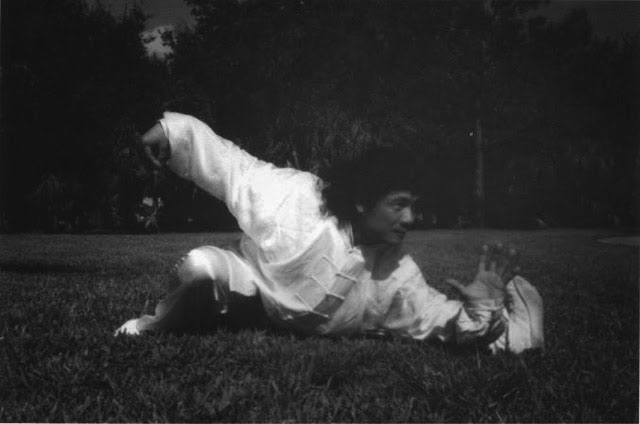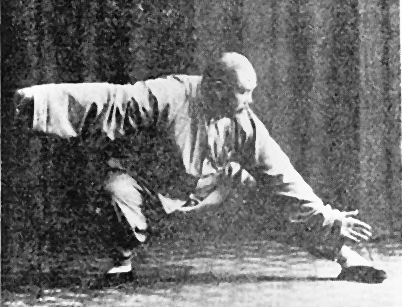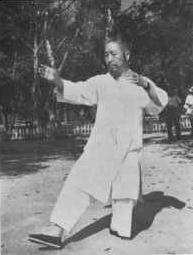In this edition of unpacking the classics we examine a line that explains the progression of training in Tai Chi. From the beginner to the advanced, from external to internal, how do we alter the focus of our training over time?
First seek extension, then contraction;
then it can be fine and subtle.
This line from the classic EXPOSITIONS OF INSIGHTS INTO THE PRACTICE OF THE THIRTEEN POSTURES by Wu Yu-hsiang is a short but perfect explanation of the process by which we begin, then advance, our Tai Chi practice.
 If one were to begin practicing Tai Chi at a young age, you would see a very different type of Tai Chi to the style we see the elderly performing. Of course, this is sensible, the young are more supple, they are more flexible and they are filled with the ability to persist during prolonged strenuous work.
If one were to begin practicing Tai Chi at a young age, you would see a very different type of Tai Chi to the style we see the elderly performing. Of course, this is sensible, the young are more supple, they are more flexible and they are filled with the ability to persist during prolonged strenuous work.
Often the training of the young in Tai Chi would be called ‘under the table’ training. This is because the postures and positions of the training would be so low as to be able to be performed underneath a table. The training postures would be the same as those commonly seen, just stretched to the absolute limit of extension. The purpose of this sort of training was to give the young adept a solid foundation of strength, flexibility and endurance at the start of their Tai chi journey. It was the domain of the ‘external’ training of Tai Chi and there would traditionally be little talk of Neigong or Neidan in their training regimen.
However, most people who start the art of Tai Chi in modern times do not do so at a very young age. Instead, most people starting their Tai Chi practice will be in the healthy adult age bracket, from 20 to 60, notably with a skew towards the upper ends of that age group.
 For these individuals the requirement to first start in ‘extension’ remains. However, this extension does not take the form of extremely deep stances or long postures. Certainly not as deep or as long as ‘under the table’ practices! Instead, the extension is sought within the body through what we call ‘medium frame’ postures, where one is are reaching out and extending within a posture that isn’t overtly demanding.
For these individuals the requirement to first start in ‘extension’ remains. However, this extension does not take the form of extremely deep stances or long postures. Certainly not as deep or as long as ‘under the table’ practices! Instead, the extension is sought within the body through what we call ‘medium frame’ postures, where one is are reaching out and extending within a posture that isn’t overtly demanding.
This extension means that the form can look somewhat mechanical at times, or can take on a stretched or overly structured look; a look that that is absent when we view the old masters in their 70s whom have been practicing for 50 years.
But this extended practice is vital in the early stages of our Tai chi journey. Once we have learned the choreography of Tai chi, be that the Nei gong movements , the qigong sequence or the form, we can begin the work of transformation. This is where the real work of tai chi begins and is the time for us to explore and identify our deficiencies and problems. Extension helps us to directly feel what is going on around the body. As the tissues pull taut they highlight any areas of tension which can then be released through the myriad of methods that Tai Chi employs for this purpose, from breathing to swings to movements.
Once we have found and resolved deficiency the continued practice in extension takes on a new purpose. In this phase we begin to build and associate the tissues together and start to create whole body connected movement. Slowly, over time, our body begins to move as a unified and connected whole and we begin to be able to exhibit Jing in our practice. Now the body becomes the conduit for the 8 powers of Tai chi and we are able to express whole body power associated with these 8 concepts and directions.
 Once this stage has been reached we must persist in the practice, constantly refining the lines, directions and feelings in the body. This constant production of extension, harmony and direction can then be consciously fed by the breath (Li
Once this stage has been reached we must persist in the practice, constantly refining the lines, directions and feelings in the body. This constant production of extension, harmony and direction can then be consciously fed by the breath (Li
Now we have started to train ‘internal skill’. The body is open, connected and harmonised (li), the breath (qi) is ‘one’ with the body and the form it takes. It is at this point that we begin to notice a difference in the entire feeling of Tai Chi. We are open and free, but are no longer physically and mentally ‘extending’. The sensation is one of retaining the outcome of motion and breath. As we move, change and proceed through our forms, the body loses its sense of extension and we begin to perceive that everything in the body and mind is one.
Finally, the external movements and postures begin to contract back in, with smaller motion, less extended posture and less obvious power; but inside much more is going on than before. Externally the form of our body(li) contracts but the power inside increases. Everything that we do is framed inside, rather than out.
So the progress from extension to contraction could be seen in this way.
Outside a lot going on; inside little going on (extension)
Outside a little going on; inside a lot going on (contract)
This process naturally occurs in the sincere and dedicated student of Tai chi. The approach must be correct, then the correct conditions will arise.